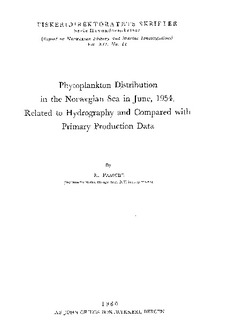| dc.description.abstract | I. Quantitative phytoplankton samples, collected during a cruise
in the Norwegian Sea in June, 1954, by the research vessel «G. O.
Sars», were worked up by means of the sedimentation metliod. Data
on hydrography, primary production, and zooplankton, were supplied
by the Research Division of the Fisheries Directorate, Bergen. The
survey included stations in Coastal, Atlantic, Arctic, and Polar water.
2. On the basis of the analyses of the phytoplankton communities,
eight vegetation areas were recognized. It was demonstrated that the
extent of each vegetation area largely depended on hydrographical
features.
3. In Norwegian coastal waters, as well as in Atlantic water in
the south-eastern part of the Norwegian Sea, the vegetation was
relatively poor, and consisted of small-celled diatoms and coccolithophorids.
In the central and north-western parts of the Atlantic region
an abundant plankton was present, consisting of Rhizosolenia styliformis
and several other diatom species of large or medium cell
dimensions, as well as of Phaeocystis pouchetii. A narrow zone of
mostly Arctic water at the border of the Atlantic water masses supported
a vegetation where the presence of Rhizosolenia hebetata f.
semispina and associated species was a characteristic feature. In Polar
waters in the north-western part of the Norwegian Sea, the plankton
was, in general, very sparse, and was composed mostly of smallcelled
algae.
4. The size of standing stocks of phytoplankton was expressed as
total cell volume (biomass) per litre of sea water. A comparison was
undertaken between available data on hydrography, phytoplankton
distribution, biomass and primary production.
5. The occurrence of large biomasses was restricted to the central
and north-western Atlantic waters. Production in these waters was
markedly higher than elsewhere in the Norwegian Sea (Berge 1958).
There was evidence that production here was largely or entirely due
to those algae which had been recognized in the preserved plankton
samples. The relative shares of the various algae in the total production
probably varied greatly between localities, but there was some
reason to believe that Phaeocystis pouchetii was, on the whole, the
most important producer.
6. Using data obtained in the course of the investigation, as well
as additional information available in literature, the development of
the vegetation in the different parts of the Norwegian Sea during
the spring of 1954, was discussed.
7. The spring increase probably started earlier in Coastal, Arctic,
and Polar waters, where stability in the uppermost strata was achieved
early in 1954, than in Atlantic water where a discontinuity layer, if
present, was then located at greater depths.
8. In June 1954, the period of high production had been brought
to an end in Coastal, Arctic, and Polar waters, possibly because of
nutrient exhaustion in the upper strata. The same was true of southeastern
Atlantic water masses, where some degree of stability was likewise
apparent. In the central and north-western Atlantic waters,
however, a general absence of stratification, in conjunction with
favourable light conditions and possibly a moderate degree of turbulent
activity, accounted for the fact that the plankton here was
apparently still at the stage of spring maximum.
9. The possible origin of the initial stocks of the various species
was discussed. There was evidence that many of the species constituting
the vegetation in the area of large biomasses and high production,
had been introduced into Atlantic water in the southern-most
part of the Norwegian Sea early in 1954. The importance of the
surface currents in distributing initial stocks was stressed.
10. The investigation amply confirmed the earlier idea (Ramsfjell
1960) that the quantitative as well as the qualitative aspects of
the spring development of the phytoplankton in the Norwegian Sea
are subject to great variations from one year to another. | |
